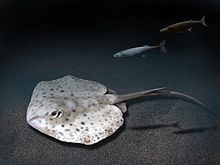| Rhombodus Temporal range: [1]
| |
|---|---|

| |
| Fossil tail spines of Rhombodus meridionalis from Khouribga (Morocco.) | |
| Scientific classification | |
| Kingdom: | |
| Phylum: | |
| Class: | |
| Order: | |
| Family: | |
| Genus: | Rhombodus Dames 1881[1]
|
Rhombodus is a prehistoric genus of ray belonging to the family Rhombodontidae.
Species within this genus lived from the Cretaceous period, Maastrichtian age to the Paleocene epoch, from 70.6 to 55.8 million years ago.[1]

Species
[edit]Species within this genus include:[1]
- Rhombodus andriesi Noubhani and Cappetta 1994
- Rhombodus binkhorsti Dames, 1881 North America
- Rhombodus bondoni Arambourg 1952
- Rhombodus carentonensis Vullo 2005
- Rhombodus ibericus Kriwet et al. 2007
- Rhombodus laevis Cappetta and Case 1975
- Rhombodus meridionalis Arambourg 1952
- Rhombodus microdon Arambourg 1952
Description
[edit]Rhombodus species could reach a length of 75–100 centimetres (30–39 in).[3] This genus is known from its caudal spines and rhombic teeth, which are all that usually fossilises. These rhombic teeth are bilobate, with vertical wrinkles and a width of about 1.5 centimetres (0.59 in).[4]
Distribution
[edit]Fossils have been found in the sediments of Africa, Europe, Asia and the Americas.[1]
See also
[edit]References
[edit]- ^ a b c d e Fossilworks
- ^ Cuny, Gilles; Martin, Jeremy E.; Sarr, Raphaël (2012-04-01). "A neoselachian shark fauna from the Late Cretaceous of Senegal". Cretaceous Research. 34: 107–115. doi:10.1016/j.cretres.2011.10.008. ISSN 0195-6671.
- ^ Cow Nosed Rays
- ^ Jim Bourdon Rhombodus - Extinct myliobatoid ray
Well, that’s interesting to know that Psilotum nudum are known as whisk ferns. Psilotum nudum is the commoner species of the two. While the P. flaccidum is a rare species and is found in the tropical islands. Both the species are usually epiphytic in habit and grow upon tree ferns. These species may also be terrestrial and grow in humus or in the crevices of the rocks.
View the detailed Guide of Psilotum nudum: Detailed Study Of Psilotum Nudum (Whisk Fern), Classification, Anatomy, Reproduction